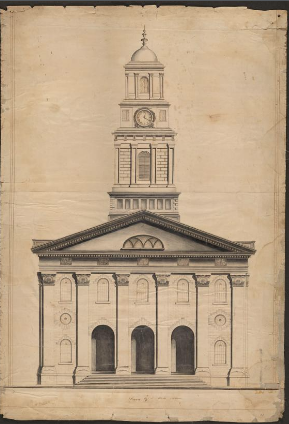William Weeks
William Weeks was the first church architect of The Church of Jesus Christ of Latter-day Saints. He was raised a Quaker and converted to the Church. He married Caroline Allen in Quincy, Illinois.
When the Prophet Joseph Smith announced plans to build a temple in Nauvoo, Illinois, Weeks and other architects submitted designs. William’s nephew, F. M. Weeks, recalled William telling him that “when [William] went in and showed his plans, Joseph Smith grabbed him, hugged him and said ‘you are the man I want.’”[1] Weeks was considered the chief architect for the Nauvoo Temple. However, the Prophet directed the work.
- Joseph Smith received many instructions about the temple by revelation, and he was considered the chief architect for the temple. Weeks then drew up detailed plans and supervised construction. However, the two did not always agree on the building details. When Joseph instructed William that the office windows on the middle floors should be round, William objected, saying that the building was too short for that style of window. Joseph replied, “I wish you to carry out my designs. I have seen in vision the splendid appearance of that building illuminated, and will have it built according to the pattern shown me.” William complied, and the temple was built with round windows.[2]
After the death of the Prophet Joseph Smith in 1944 and the resulting pressure to leave Nauvoo, Brigham Young called Weeks and his family to leave with the first groups of Saints in early 1846. Truman Angell was given the responsibility to finish the temple.
Brigham Young wanted Weeks to begin work on a new temple in Salt Lake as soon as the Saints were settled, but soon after arriving in the valley, William and his family left the Church, possibly over his objection to plural marriage.[3]
The family moved back to the Midwest for five years before returning to Utah and the Church for a few years. However, the family moved to California in 1857. Weeks died on March 8, 1900, apparently estranged from the Church. He never worked as an architect again; instead, he worked as a carpenter and ran a gristmill. He later purchased cows and opened a dairy in Hollywood, then moved it to Green Meadow, just north of Los Angeles. He retired to a small ranch in Palms, California.
Weeks kept his drawings of the Nauvoo Temple and his daughter Caroline Weeks Griffin had them in her keeping until she passed them on to her son Leslie.
In 1948, when missionaries serving in the small desert town of Boron, California, knocked on the door of Leslie and Zetta Griffin. “The missionaries built a good relationship with the Griffins, and Leslie, who was not a member of the Church, told the elders that they had William’s architectural drawings. The Griffins felt strongly that the drawings should be returned to the Church. They asked one of the elders, who was returning home to Utah in a few days, to give the drawings to the Church archives.”[4]
The drawings were instrumental when the Church rebuilt the Nauvoo Temple. Bishop Keith B. McMullin, then a member of the Presiding Bishopric, said, “Efforts have been made to reflect as closely as practical the original exterior designs and interior appointments. Brother Weeks’ drawings were an essential part of this study and research. The manner in which the Nauvoo Temple has been reconstructed would not have been possible without these original plans.”
Weeks was born on March 11, 1813, into a family of builders. His father, James, taught his building and architectural skills to William and his brother Arwin.
